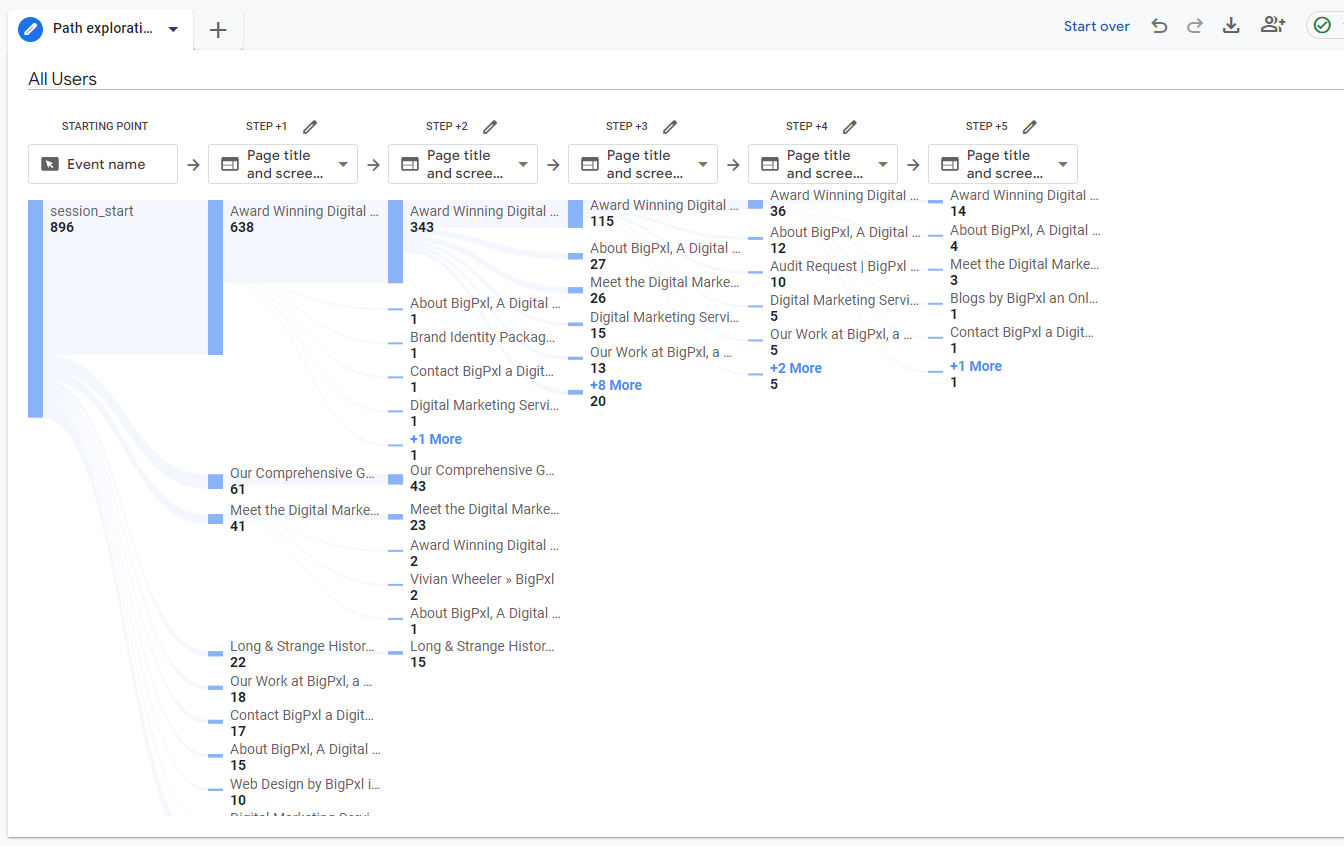Is your website optimized for the four main reasons people search online? A website that accounts for search intent gives your marketing team a better picture of how people find and interact with your website, allowing you to target marketing campaigns and content more effectively.
Discover how to dive headlong into search intent when developing your sitemap. First, we look at the details of search intent. Second, we’ll show you how to implement this strategy when building pages on your website with a sitemap, whether you already have a website or not.
Related Post: BigPxl’s Brief Guide to Keeping Your Website Secure
What is search intent?
Search intent, used interchangeably with the terms user intent or audience intent, describes the fundamental reasons why someone wants to find information about your brand. You need to take into account user intent when people try to find your site.
Marketers outline four types of audience intent:
- Navigational
- Transactional
- Informational
- Commercial investigation
For the example of this blog, we’ll use the brand name Acme Time in Springfield, Missouri. This brand sells and repairs watches and clocks. It also sells calendars, planners, and other things that help people manage their time.

Navigational Search Intent
Navigational intent talks about someone trying to find something specific, such as a product, website, page, or location.
Someone with navigational intent would search for the “Acme Time website” or “Acme Time Facebook” to navigate to a specific web page for your online presence.
Another example would be “Acme Time watch repair” to see an exact page on your website. “Acme Time inventory” or “Acme Time watches for sale” could indicate someone is trying to find your online inventory.
Lastly, if you have a physical location people can visit, such as a shop or storefront, navigational intent talks about how people can find your location.
Discovering your location might include:
- Acme Time location
- Watch repair near me
- Clock repair Springfield, MO
- Used watches near me
- New watches near me
Someone will need a virtual road map to complete an internet search based on navigational search intent. That map could lead to a website, specific web page, social media account, Google Maps page, or an Apple Maps listing.
Transactional Search Intent
Transactional search intent indicates someone wants to purchase something immediately. Many times, this means a user already knows what they want to buy, and they want to get to a product page quickly. Transaction intent also means you need to set up a secure purchase portal or an appointment/request a quote option for your services.
Searches for Acme Time with transactional intent might look like this:
- Buy a used watch in Springfield, MO
- Used watches near me
- Buy a used Timex watch
- Watches for sale near me
- Acme Time clocks for sale
- New clocks in Springfield, Missouri
- Luxury watches Springfield, MO
- Watches discounts
If you notice the searches we just listed, they may overlap among multiple intents! “Used watches near me” might reveal someone trying to find your shop (navigational) or buy something from your shop (transactional). Someone either wants to come to your shop or make a purchase.
However, both of these search intents require a different kind of web page to drive conversions.
Navigational intent for “used watches near me” needs a listing on Google Maps or Apple Maps, or a location page on your website.
Transactional intent for “used watches near me” requires an inventory page or a page featuring used watches.
This is where developing your sitemap for search intent becomes essential.
Informational Search Intent
Informational search intent means someone needs to know something, whether they want to buy something from your brand or not.
Information about your brand can come in many forms. Back to the Acme Time example, someone may want to know when they should take their watch in for repairs, how to value an old watch, how long watch batteries last, or what to do if your watch gets water in it.
Informational search intent can also come from people who want to know more about your company, such as how long you’ve been in business, the history of your company, or what services you provide and how you provide them.
Other informational searches could be how much certain brands of watches cost, how to price used watches, or what an antique cuckoo clock could be worth. These searches can overlap with transactional intent depending on what types of timepieces Acme Time sells.
Think of informational search intent as someone asking a question and seeking answers. Many informational searches will have questions associated with them.
Blogs and complete guides represent beneficial content for informational search intent when people want to find out about watches and clocks without necessarily buying something. They offer you a chance to show off your expertise.
Some of this informational content can live on your products or services pages. However, you need also to make these pages work for transactional intent, so people can easily buy something or set a service appointment for repairs. This is why you might separate transactional intent from informational intent in a sitemap. Consider having some information on your conversion-based pages with more verbiage and even how-to videos on guides or blogs.
Commercial Investigation
Commercial investigation, or simply “commercial,” is a version of transactional intent with a longer timeframe. Users investigate whether or not they want to purchase something, and your brand needs to stand out to capture some of that market.
Commercial investigation searches might look like these:
- Timex watch reviews
- Timex watch models
- Luxury watches in stock
- Top 10 luxury watch brands
- Best Rolex watches for scuba diving
- Best new watches in 2023
- Discounts on new watches
- Sales on new watches
- Watches for sale in Springfield, MO
- Watches for sale
- Cost to repair a watch
- How much to fix a clock
These types of searches outline the intent for purchase, but they need more time to do their research before deciding. This segment of your audience isn’t sure what they want to buy from whom, so they try to investigate the best option for their needs at the right price for products or services.

How do I know what type of intent is in a search?
Words in a search might give you a clue as to the type of search intent your audience uses to find your web presence.
Navigational searches might contain these words:
- Where
- Near me
- Place names like Springfield, New York, Los Angeles, Missouri, and California
- Map
- Where can I
- Find
Transactional intent searches could have words like:
- Buy
- Purchase
- Sale
- Deal
- Discount
- Product names (Rolex, Timex, Seiko, Omega)
Informational searches may have words such as:
- How to
- Why
- How
- Information
- Best way to
Commercial investigation searches might contain these words:
- Reviews
- Best
- Models
- Brands
- Top
These four search intents can help you develop pages for your website as you fill out your sitemap.
Why is search intent important for SEO and your sitemap?
Because you don’t know why someone will search for your site, you need to have a web page ready for each search intent.
Some search intents have a time element, like someone heading to your shop now or wanting to buy a watch now. Other search intents can lead to developing a page that drives conversions. Still others allow you to showcase your expertise, which can also lead to conversions at some point.
Here are the steps you can take to build a website structure, web pages, and a sitemap to help draw traffic based on search intent.
Search Intent Speaks to Your Audience Personas
Develop audience personas to help your team understand the types of people who will look for your website. Creating personas allows you to get inside the heads of why someone would search for your brand, leading you to how they navigate your brand’s online presence.
Acme Time wants to drive a specific type of customer to their website. They also have actual customers who purchase their items in the store or online. In a push to improve their website, Acme Time needs to know what pages to build based on the traffic they see and the keywords people use to find their website. This leads to two types of audience personas: Customer personas and ideal customer personas. The first group represents the people already interacting with the brand. The second represents the people a brand wants to attract.
To get to the heart of a customer’s wants and needs, you need to determine the demographics and psychographics of the people you want to reach.
Demographics include:
- Location (where they live)
- Income level
- Occupation
- Gender
- Family
- Age
- Education level
- Religion
- Ethnicity
Psychographics, which deal with your audience’s behavior, include:
- What drives your customers?
- Why do customers search for your brand?
- What hobbies do your customers have?
- What lifestyle do they lead?
- What beliefs do they have?
Demographics are the “what” behind your audience, while psychographics denotes the “why” of your audience’s motivations. The more information you know about your existing and ideal customers, the better idea you will have about how they will interact with your website.
For instance, the majority of Acme Time’s customers are in Springfield, Missouri, living south of Sunshine Street, making more than $60,000 a year, and around age 50 with college degrees. Another large segment of people are retired and have a limited income.
However, Acme Time would like to expand its reach to online sales and a younger audience. To do so, they’ll need to determine why someone online or in their 20s and 30s would want to explore a company that sells and repairs watches and clocks.
You can create as many audience personas as you need. You might find that 95% of your sales come from three different types of people. But to expand your sales, you want to drive traffic for two other types of audience members.
Once you develop personas, it’s time to look at how they would interact with your website, called a user journey.

Your Audience Takes a User Journey Through Your Website
A user journey shows how your audience moves from one page to another on your website in order to drive conversions. Conversions from your website are the ultimate goal, typically making contact or purchasing. User journeys move your audience through your website to an end goal.
Most people start on the home page. Then they might navigate to an inventory page, products page, or services page before heading to a contact page. Your users may not even need to go to a contact page to convert if you set up your website correctly.
If you want customers to convert from any page they land on, you can have several elements on each page that foster purchases or appointments. In Acme Time’s case, they would want a quick link for their inventory and a shopping cart while also having a button or quick form to make a service appointment (depending on if someone is there to buy a timepiece or get one fixed).
Another conversion point could be a button to call Acme Time directly. Yet another conversion might come from a short quiz that narrows down why someone has come to the website by answering a series of quick questions. The answers to the questions will direct a user to a convenient conversion point, such as making a service appointment or landing on a category page for your inventory, like “dive watches.”
The beauty of having conversion points on every page is that you can have these elements on your pages that aren’t focused solely on conversions, such as store location pages, guides, or blogs.
The shorter your user journey from landing on a page to conversion, the better. Having an effective sitemap can foster an efficient user journey.
Setting Up a Sitemap Based on Search Intent
Now we’ll show you how to set up a sitemap based on your customers’ search intent as they move through your website from page to page based on search intent using the Acme Time example. You’ve already determined your target audience and how they move through your website. Now we’ll look at setting up a sitemap to foster search results based on the four types of search intent.
Navigational Pages
Every page on your site can boost navigational search intent for specific products, product categories, an inventory page, a service page, and individual service pages if someone looks for a particular page. Navigational also refers to finding your store, so you must set up a Contact page and individual location pages with Google Maps.
Keywording on these pages should mimic searches. If you want people to find a page about “watch repair in Springfield, MO”, consider having the H1 title for that page be the keyword “Watch Repair”. Google will know the company is in Springfield due to the address on the site, on Google Maps, and with the address on the contact and location pages.
Transactional Pages
Every page can be transactional with the proper conversion points. However, some pages can point a user to a purchase point for a product or service.
For Acme Time, the brand would require several pages for transactional intent:
- A general inventory page
- Category pages, like new watches, used watches, new clocks, and used clocks
- Pages featuring various brands, such as Rolex, Seiko, and Timex
- A general services page
- Watch repair
- Clock Repair
If this brand wants people to come to a storefront, having keywords for things like clock repair and watch repair would also be relevant on a contact page and location page, even though both of those pages are primarily for navigational intent.
Informational Pages
People who are ready to convert don’t necessarily need much information on a page besides the product or service information and what people get for their price. However, people who want to know more about clocks and watches can find the information they need through guides and blogs.
Informational pages serve other purposes for your website. Google favors pages with expertise, authoritativeness, and trustworthiness. These pages get to showcase expertise within your chosen field.
For Acme Time, comprehensive guides about common watch repairs, top watch brands, common clock repairs, valuing antiques, and pocket watches would all be appropriate, depending on what the brand knows best.
These guides can serve as pillar pages: longer pages of content with comprehensive information that link to shorter blogs that dive into more details about a topic. For instance, Acme Time creates a complete guide to repairing antique cuckoo clocks. One paragraph briefly discusses identifying an antique cuckoo clock and links to a blog about how to identify antique cuckoo clocks. In turn, the blog post links back to the pillar page.
Video is a great way to disseminate information for how-to and review pages.
Commercial Pages
Commercial investigation for Acme Time can simultaneously function as information-rich, transactional, and commercial pages.
For Acme Time, they can post reviews of watches they have in stock, not just written but video reviews as well. Videos are fantastic to include on commercial investigation pages because users love watching or listening to videos. You’ll need the verbiage on the page to rank for SEO and a video to maintain the attention of your audience.
For a top 10 list as a commercial investigation page, Acme Time can have varied topics like “Top 10 Rolex Models in History” while having photos from the inventory and links to the individual product pages.
Again, this is how you can boost multiple search intents on various pages. You have to set up the individual pages and your sitemap correctly so that every person seeking your brand can navigate your site to make conversions easier.
How do we find the search terms people use to find your website?
Marketers have some major tools to find what search terms people use to find a website after one is live. You can use these tools to see what your web pages are actually ranking for.
- Google Search Console
- A Google search
- SEMrush and similar SEO tools
For the user journey, that map appears in Google Analytics, either Universal Analytics or GA4.
Related Post: What Makes a Good Keyword for SEO?
Partner With Experts Who Can Build a Conversion-Focused Website Geared for Search Intent
A marketing agency can help your team build a conversion-focused website with search intent in mind. We’ll help you build buyer personas, a user journey, and a sitemap worthy of your brand.
Contact BigPxl or call (417) 799-2233 for a consultation. We’re happy to help in any way we can.





